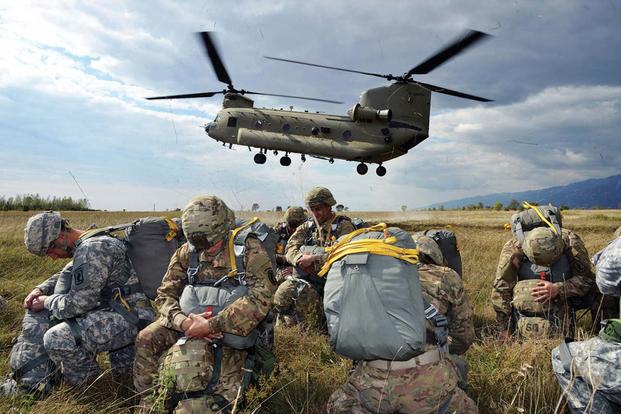U.S. Army leaders today wrestled with the challenges of equipping and supplying soldiers in what the service sees as a multi-threat battlefield of the future.
To Gen. Gustave F. Perna, the Army has grown too dependent on contractor support to sustain its combat units, a practice that has led to bad habits over the last 15 years of war.
"I personally believe we are not ready to execute a decisive action fight against a near-peer competitor," said Perna, the commanding general of Army Materiel Command, before an audience at the Association of the United States Army's Global Force Symposium and Exposition in Huntsville, Alabama.
"It's not because we don't have the great leaders and soldiers who have been trained in the last 15 years … it's because the skills we need for sustainment have atrophied."
Army leaders are keenly focused on the service's vision of Multi-Domain Battle, a picture of warfare in the not-too distant future that will challenge brigade combat teams and higher command structures across land, sea, air, space, cyber and electromagnetic domains.
"Will we be able to overcome the capability that eliminates a whole brigade while it's enroute from a [United States] installation to the next fight?" Perna asked.
"Can we project ourselves, can we receive ourselves and can we execute onward movement to the battlefield while there will be an enemy … that will do everything in their power to stop us before we get there?"
Paul Rogers, director United States Army Tank Automotive Research, Development and Engineering Center, or TARDEC, said he believes that all future conflicts end up in a complex urban environment.
The enemy "will always melt back into that environment that tends to equalize our advantage, and when they do that we need to be prepared to fight and win in that environment," he said.
Four years ago, Rogers' office began using Soldier Innovation Workshops as a way to gain insight on what soldiers need in the next generation of combat vehicles.
The workshops are made up of soldiers E5 to E7 from units such as the 82nd Airborne and 1st Cavalry Division as well as the 3rd Armored Cavalry Regiment.
"We give them a challenge ... how would you develop or design the future fighting vehicle? What are that attributes you would like to see?" Rogers said. "And we pair them up with creative designers from an industrial design college that we have in Detroit.
"So the soldiers are describing the attributes of the future systems they would like to see and those college students, who are really more artists than they are technical, but they can real-time draw exactly what you are describing and by the time you get done talking, they turn the picture around and say ‘is this what you are describing?'"
The workshops last 2.5 days and yield about 300 advanced concepts, Rogers said.
"It's really a great way for us to grab innovation from the soldier and bring it into the technology developments," he said. "Those ideas -- we are not only leveraging them in our more near-term advancements and changes to current vehicles, but we are also looking for the future vehicle systems and they are coming out of it."
One of Rogers' biggest concerns about Multi-Domain Battle is "our ability to logistically support and sustain over vast distances and over long periods of time when our logistical support can be [disrupted] by kinetic ops or cyber."
"If we want to have decentralized independent action of our combat forces, we have to figure out how to protect and assure that logistical resupply in a near-peer fight," said Rogers.
This is also a concern Perna shares.
A ship sinking or a train blowing up could result in a "whole BCTs worth of equipment could be lost," Perna said.
At Army Chief of Staff Gen. Mark Milley's direction, AMC is focused right now on making sure that "Army preposition stocks are prepared and ready to go," Perna said.
"They will not be worth our time if we do not have the right equipment on our APS set. Not only the right equipment but equipment that will work when we pull it off of the ships; equipment that works and has the right radios the right weapons, the right command structure, the right weapons so that we are ready to fight at a moment's notice."
-- Matthew Cox can be reached at matthew.cox@military.com




























